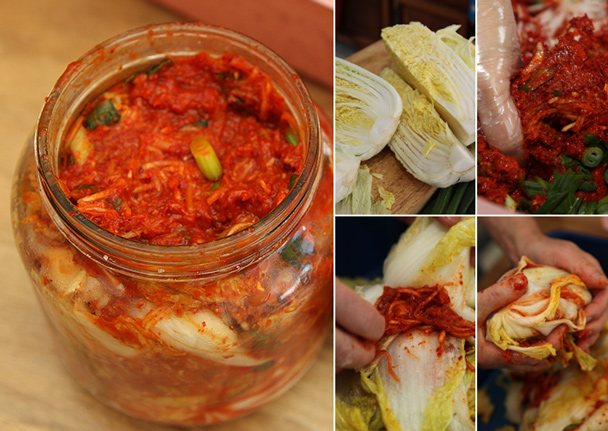Sometimes before I introduce my friends to my Korean mother, I like to explain that she's like a walking, talking bowl of kimchi: fiery, overbearing, and takes some getting used to, but she'll stick with you a long, long time.
There's another thing kimchi and my mother have in common: I can't recall life without them. OK, chocolate is my first food memory, but kimchi came next. And it was part of almost every family dinner until I left our suburban New Jersey home at 18. Thanksgiving? Kimchi was next to the cranberry sauce. Christmas? Kimchi goes great with ham. And what do kids love better for an impromptu weekend lunch than a peanut butter and jelly sandwich? Well, this kid loved PBJ&K.
My blood didn't run spicy-kimchi-juice orange from birth, though. First came baechu kimchi (the leafy kind made from Chinese cabbage that is most familiar to Americans), but carefully rinsed of extra heat by my parents in cool water, turning it into a shorthand form of mul kimchi or "water" kimchi. By the time I was 10, I was eating baechu kimchi without dilution, and my mother and father knew to set aside for me a little dish of yeolmu kimchi—the dark-green leafy strands of chong gak kimchi, the radish kimchi known as "bachelor's" or "little boy" kimchi. I appreciated the stringiness and extra crunch of these coarse stems, and liked the way the bitterness offered a more complex panoply of tastes than just sourness and heat. (There are a couple of explanations for chong gak kimchi's name, by the way: One's that it's simple enough for a unmarried man to make. My mother, however, once told me she prefers to think it earned the name because the radishes supposedly look like little boys' penises. I've tried to chop chong gak kimchi into safely non-anatomical geometric cubes before eating it ever since.)
Growing up, though, it wasn't easy to explain my love of kimchi to my non-Korean friends. They came over for dinner often, and wolfed down bulgogi by the platter. But the kimchi always stood untouched, soaking in its red-orange juice like a homely girl in a hot tub: tons of personality, but you have to plunge in and really take the time to get acquainted. Even my little brother avoided it, and never made it past the mul kimchi stage—he still begs off from kimchi to this day. One thing my friends did find kimchi useful for, however, was as a punishment for losing a dare. I didn't mind losing dares.
Once, my fourth-grade teacher, Miss Krauss, asked me to bring in a jar from home after the previous night's episode of M∗A∗S∗H had kimchi playing an integral role in Hawkeye Pierce's weekly comeuppance to Charles Winchester III. Miss Krauss came away with the impression that kimchi was basically a variety of sauerkraut, and she loved sauerkraut. It turned out she did not love kimchi. But at least I never again had to be accused of being the teacher's pet—the other kids knew I wasn't sucking up to the teacher, since I had brought her something she hated.
After I left home, I rarely had kimchi unless I managed to smuggle a jar out of my parents' kimchi fridge (yes, there are special fridges just for kimchi) on one of my infrequent visits. Much later, the sudden explosion of Korean cuisine on the restaurant scene didn't help. Suddenly everyone loved kimchi, and swore by the stuff served at the latest Korean hot spot. I tried them all. None of them was ever as good as my mom's. They just weren't…right.
This year, I finally decided to ask my mother to teach me how she makes it. Her way, I stressed, just like when I was growing up. Kimchi-making is a deeply seasonal event, tied to the harvests and family and communal preparations for the often brutal Korean winters, and toward the end of summer, she'd usually spend every weekend preparing and packing away large glass jars of the stuff to meet our voracious dad's appetite through the winter.
No problem, Mom said. Come on down.
Recently, I found myself at the kitchen table where I grew up eating most of my meals. My brother's kindergarten hand-turkey still graces the corkboard by the telephone, as does the truly frightening bug-eyed clay medallion of his own face he made in first-grade art class. Important phone numbers written in my mother's small, meticulous script crowd the rectangular cardboard that originally came from inside a Sears Oxford-collar shirt and has spent years pinned next to Andrew's hand-turkey—you can chart the course of my life by the area codes of the phone numbers crossed out by my name through the years: Chicago, Virginia, North Carolina, Manhattan, Brooklyn.



 Pinterest
Pinterest


